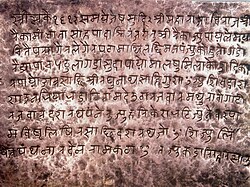Nepali language
The Nepali language is the official language of Nepal and a language in India. Besides Nepal it is spoken in India, Bhutan and parts of Burma. In the Indian states of Sikkim and West Bengal also it is an official language. This language is also known as Gorkhali Language or Khaskura. It is believed to have originated from the ancient Sanskrit language from which it takes many words. It is written in Devanagari style of writing which is similar to Hindi. It is spoken throughout Nepal and is the mother tongue of more than half of the population. It is also used by the Government of Nepal for all official purposes. In Nepal it is compulsory to study Nepali language as a subject until Grade 10 (High School).
| Nepali | ||||
|---|---|---|---|---|
| Gorkhali, Khas-kurā नेपाली गोरखाली | ||||
 The word "Nepali" written in Devanagari | ||||
| Native to | Nepal and India | |||
| Ethnicity | Khas people[1] | |||
| Native speakers | 20 million (date missing)e18 | |||
| Language family | Indo-European
| |||
| Writing system | Devanagari Devanagari Braille Takri (historical) | |||
| Official status | ||||
| Official language in | ||||
| Regulated by | Nepal Academy | |||
| Language codes | ||||
| ISO 639-1 | ne | |||
| ISO 639-2 | nep | |||
| ISO 639-3 | nep – inclusive code Individual codes: npi – Nepali dty – Doteli | |||
| Linguasphere | 59-AAF-d | |||
 World map with significant Nepali language speakers Dark Blue: Main official language, Light blue: One of the official languages, Red: Places with significant population or greater than 20% but without official recognition. | ||||
|
| ||||
| Part of a series on | |
|---|---|
|
| |
| Constitutionally recognised languages of India | |
| Category | |
| Scheduled Languages | |
|
A
| |
| Related | |
|
Official languages of India
|
| This language has its own Wikipedia project. See the Nepali language edition. |
Nepali Language Media
A map showing languages of the Indian subcontinent c. 1858; It refers to the language as "Nepalee".
A simplified overview of the Indo-Aryan language family.
Copper Inscription by King of Doti, Raika Mandhata Shahi, at Saka Era 1612 (1747 BS) in old Nepali language using Devanagari script
Manuscript of Bhanubhakta Acharya's Bhanubhakta Ramayana led to "cultural, emotional and linguistic unification" of Nepal.
A statue of Bhanubhakta Acharya at Chowrasta, Darjeeling
Geographic distribution of the Nepali language as their mother tongue in the Indian subcontinent.
Bhanubhakta Acharya, Aadi Kavi in Nepali-language literature
References
- ↑ Richard Burghart 1984, pp. 118-119.






